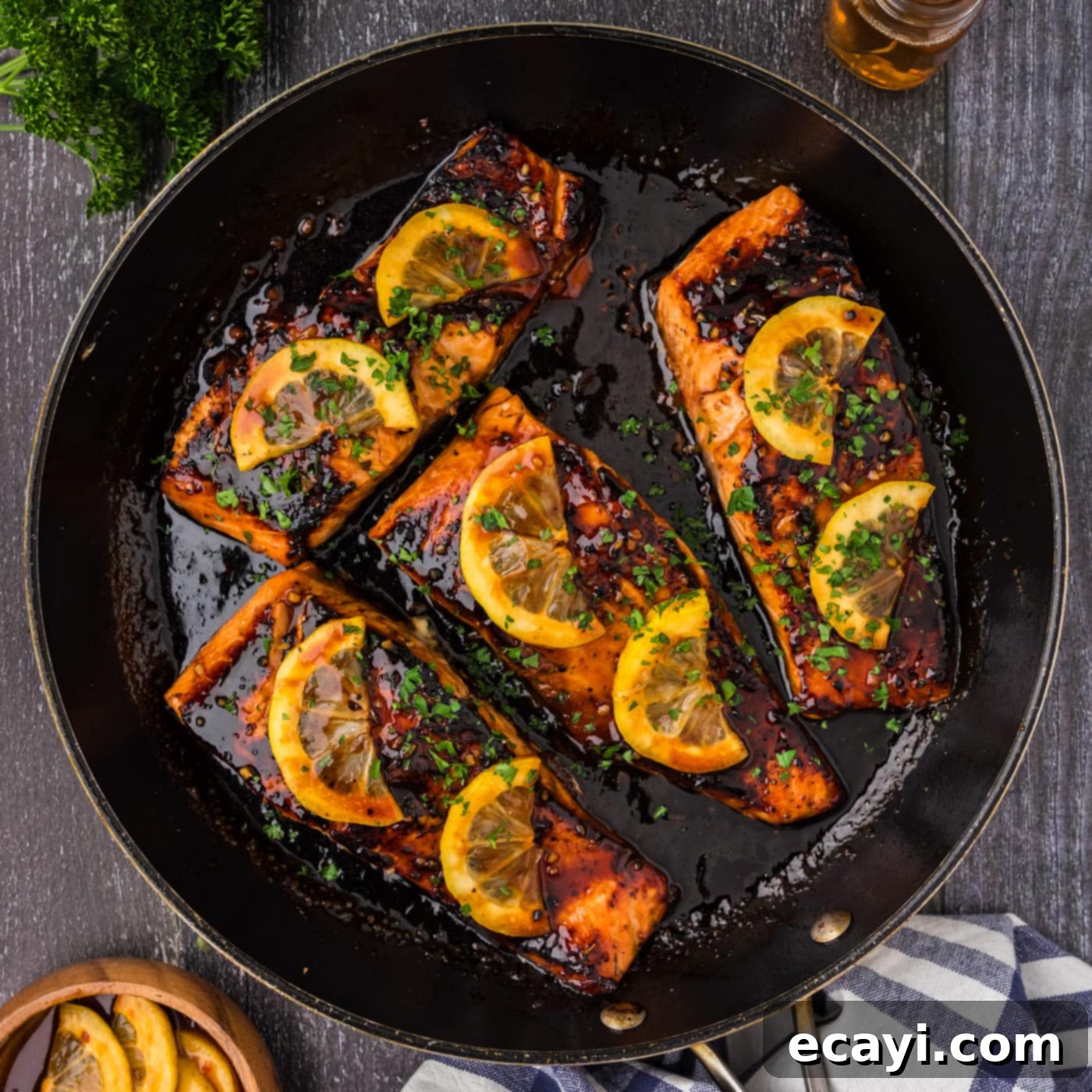Easy 25-Minute Honey Garlic Salmon: Pan-Seared Perfection with a Sticky, Sweet & Savory Glaze
Prepare to elevate your weeknight dinner routine with this incredible honey garlic salmon recipe. Featuring a mouthwatering, sticky-sweet, and savory glaze, this dish promises an explosion of flavor on every plate. Best of all, it comes together effortlessly in a single skillet in just about 25 minutes, making it a perfect choice for a quick yet impressive meal. Whether you’re a seasoned chef or a kitchen novice, this recipe is designed for simplicity without compromising on taste.
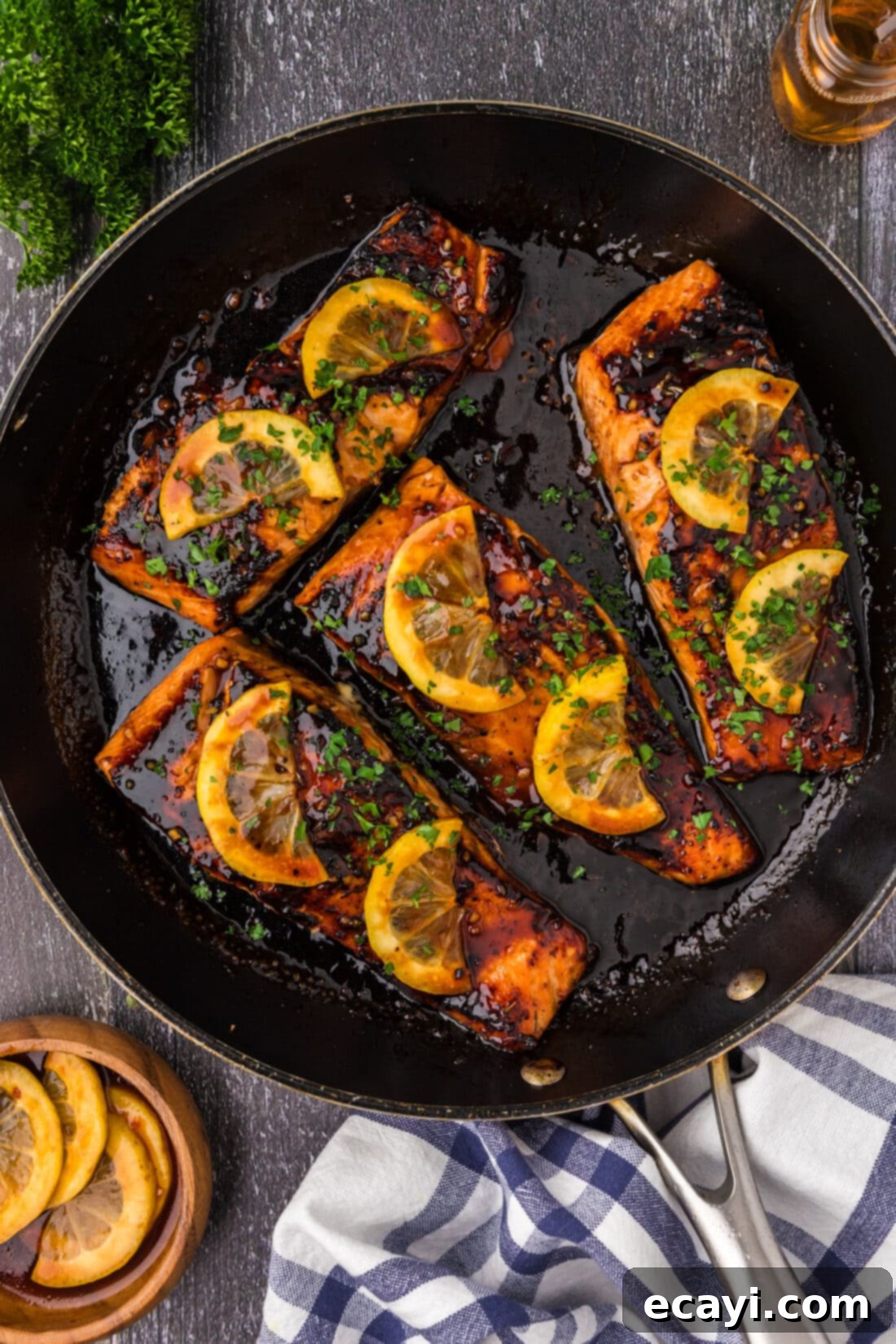
Why This Honey Salmon Recipe Is a Must-Try
The star of this dish is undoubtedly the delicate yet intensely flavorful glaze that coats each piece of tender, flaky salmon. This isn’t just any glaze; it’s a harmonious blend of honey’s natural sweetness, the umami depth of soy sauce, the subtle kick of Asian sweet chili sauce, and the aromatic warmth of fresh garlic. Together, these ingredients create a profile that is both irresistible and perfectly balanced, complementing the rich flavor of the salmon. We love this honey garlic salmon so much that we often prepare a double batch of the glaze, storing the extra in a jar to drizzle over white rice, steamed vegetables, or even other proteins throughout the week.
Salmon is an incredibly versatile fish, lending itself beautifully to a myriad of culinary styles. However, there’s something truly special about a well-executed glaze that draws us in. Similar to popular dishes like teriyaki salmon or maple soy salmon, this honey garlic iteration showcases how brilliantly the supple salmon fillets pair with a sticky, flavor-packed coating. This recipe stands out for its ability to deliver restaurant-quality taste with minimal effort and time, making it an ideal candidate for busy weeknights or when you simply crave something extraordinary without the fuss.

Key Ingredients for Your Honey Garlic Salmon
Crafting this delectable honey salmon requires a few simple yet impactful ingredients. You’ll find a complete list of measurements and detailed instructions in the printable recipe card at the conclusion of this post. For now, let’s highlight the stars of the show:
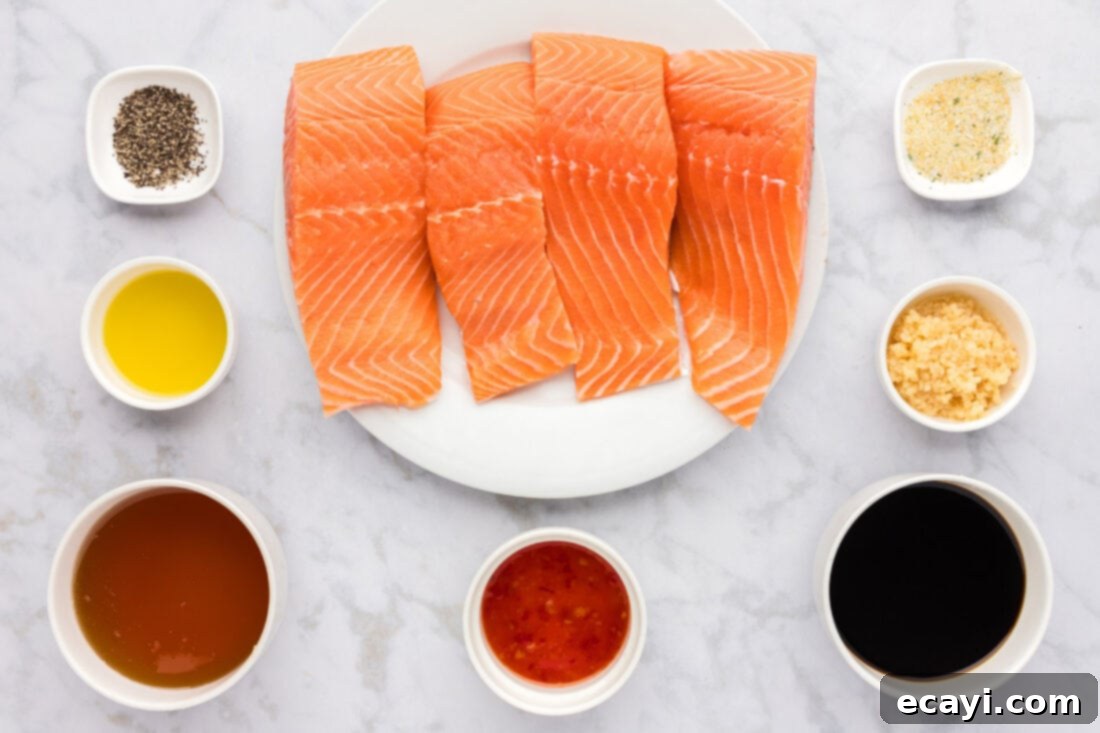
Ingredient Insights and Smart Substitutions
Understanding your ingredients is key to culinary success. Here’s a deeper dive into what you’ll need and how you can adapt if necessary:
SALMON: For the best and most consistent results, we highly recommend using center-cut salmon fillets. These cuts offer uniform thickness, ensuring that all pieces cook evenly. A sharp chef’s knife will allow you to easily portion a larger fillet into four smaller, approximately 8-ounce servings. While fresh salmon is always preferred for its superior texture and flavor, frozen salmon can certainly be used. If opting for frozen, make sure to thaw it completely overnight in the refrigerator before cooking. Patting the salmon dry thoroughly with paper towels before seasoning is crucial for achieving that beautiful sear and preventing it from steaming in the pan.
THE IRRESISTIBLE GLAZE: The magic of this dish lies in its perfectly balanced sauce. It’s a symphony of flavors created by a precise combination of:
- Honey: The primary sweet component. Any good quality honey will work, but lighter floral honeys will allow the other flavors to shine through more clearly.
- Soy Sauce: Adds a fundamental savory, umami depth. For those monitoring sodium intake, low-sodium soy sauce is a fantastic alternative. If you’re looking for a gluten-free option, tamari is an excellent substitute that maintains the flavor profile.
- Asian Sweet Chili Sauce: This ingredient is a game-changer, providing a wonderful sweet, tangy, and subtly spicy element. It adds a layer of complexity that truly elevates the glaze. If you don’t have it on hand, a small amount of sriracha mixed with a touch of sugar and vinegar can offer a similar sweet-heat balance, though the depth won’t be identical.
- Minced Garlic: Freshly minced garlic is always best for its pungent aroma and robust flavor. Pre-minced garlic in a jar can be used for convenience, but fresh offers a more vibrant taste.
- Cornstarch Slurry: A simple mixture of cornstarch and water is used to thicken the sauce into that desirable sticky glaze consistency. This ensures the sauce clings beautifully to the salmon fillets, maximizing flavor in every bite.
Crafting Your Perfect Honey Salmon: Step-by-Step Guide
These step-by-step photos and detailed instructions are designed to guide you through making this delicious honey salmon recipe. For a quick reference, you can Jump to the full printable recipe card, complete with exact measurements and detailed instructions at the bottom of this page.
- Prepare the Glaze: Begin by combining the honey, soy sauce, Asian sweet chili sauce, and minced garlic in a small saucepan. Whisk these ingredients together until thoroughly combined. Bring the mixture to a gentle boil over medium-high heat, stirring frequently to prevent sticking or burning. Once it reaches a boil, immediately remove the saucepan from the heat.
- Thicken the Glaze: In a separate small bowl, create a cornstarch slurry by whisking together the cornstarch and a small amount of water until smooth. Gradually whisk this slurry into your prepared sauce in the saucepan. Return the saucepan to low heat, stirring continuously, just long enough for the sauce to begin to thicken to a lovely glaze consistency. It should coat the back of a spoon. Do not overcook. Remove from heat once thickened.
- Prepare the Salmon: If your salmon fillets appear moist, gently pat them thoroughly dry with paper towels. This step is crucial for achieving a nice sear. Season both sides of the salmon generously with garlic salt and black pepper according to your taste preferences.
- Heat the Skillet: Add olive oil to a large, heavy-bottomed skillet and heat it over medium-high heat. Ensure the oil is shimmering before adding the salmon to prevent sticking and encourage a good sear.
- Sear the Salmon: Brush the seasoned salmon fillets with a generous amount of your prepared honey garlic glaze. Carefully place the salmon into the hot skillet, skin-side up (flesh side down initially, for better searing and brushing the skin later if desired, or as depicted in the original image where it’s skin-side down in the pan, which means the flesh is up). Brush the visible side (which would be the skin side if placed flesh down) with additional sauce. Cook for approximately 6 minutes. During this time, you’ll notice the flesh starting to change color from a translucent pink to a paler, opaque pink as it cooks through.
- Flip and Finish: Using a fish turner spatula, carefully flip the fillets over. Add any remaining sauce directly into the skillet around the salmon. Reduce the heat to medium and continue to cook for an additional 3 minutes. The sauce in the pan will become bubbly and further caramelize, coating the salmon beautifully.
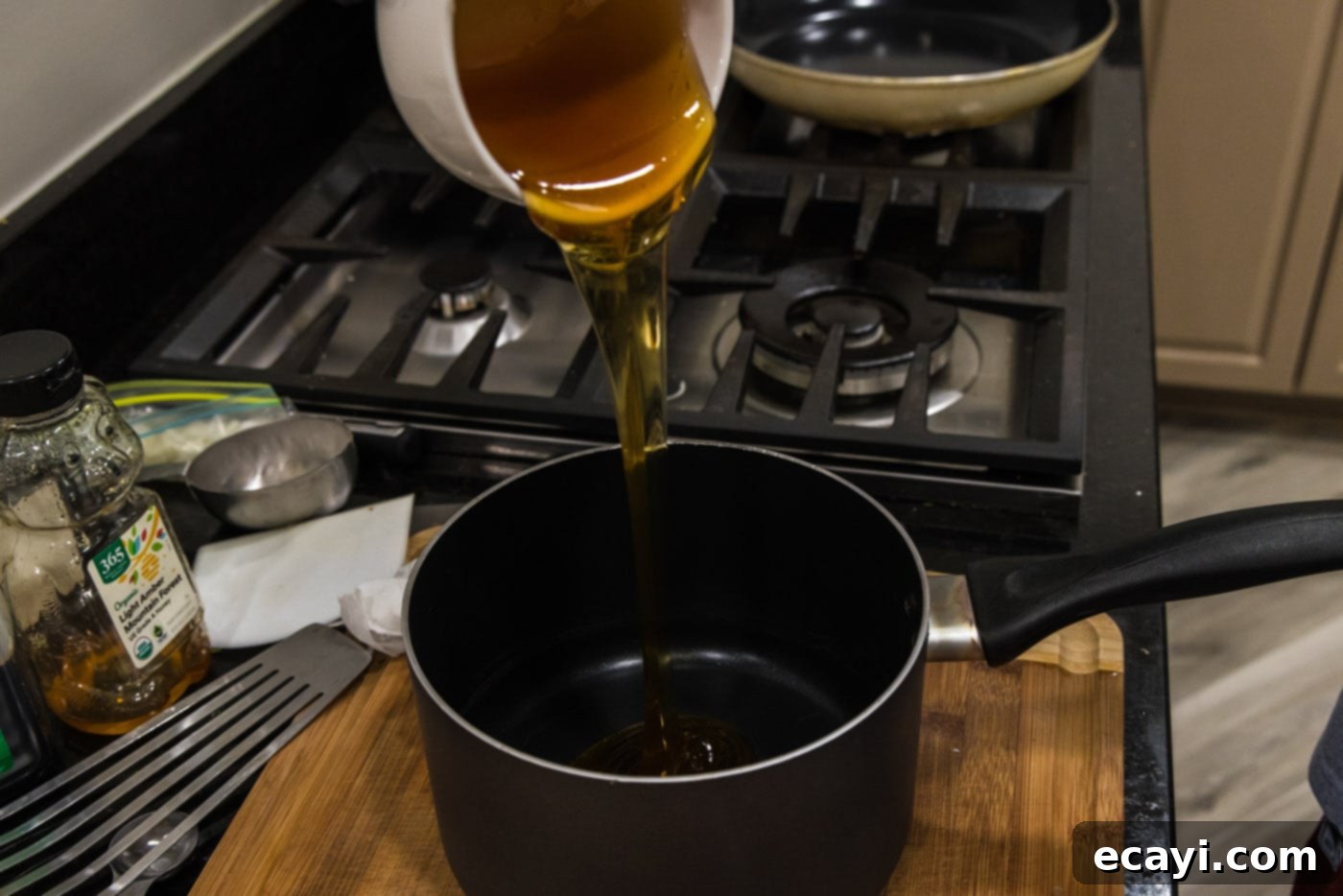
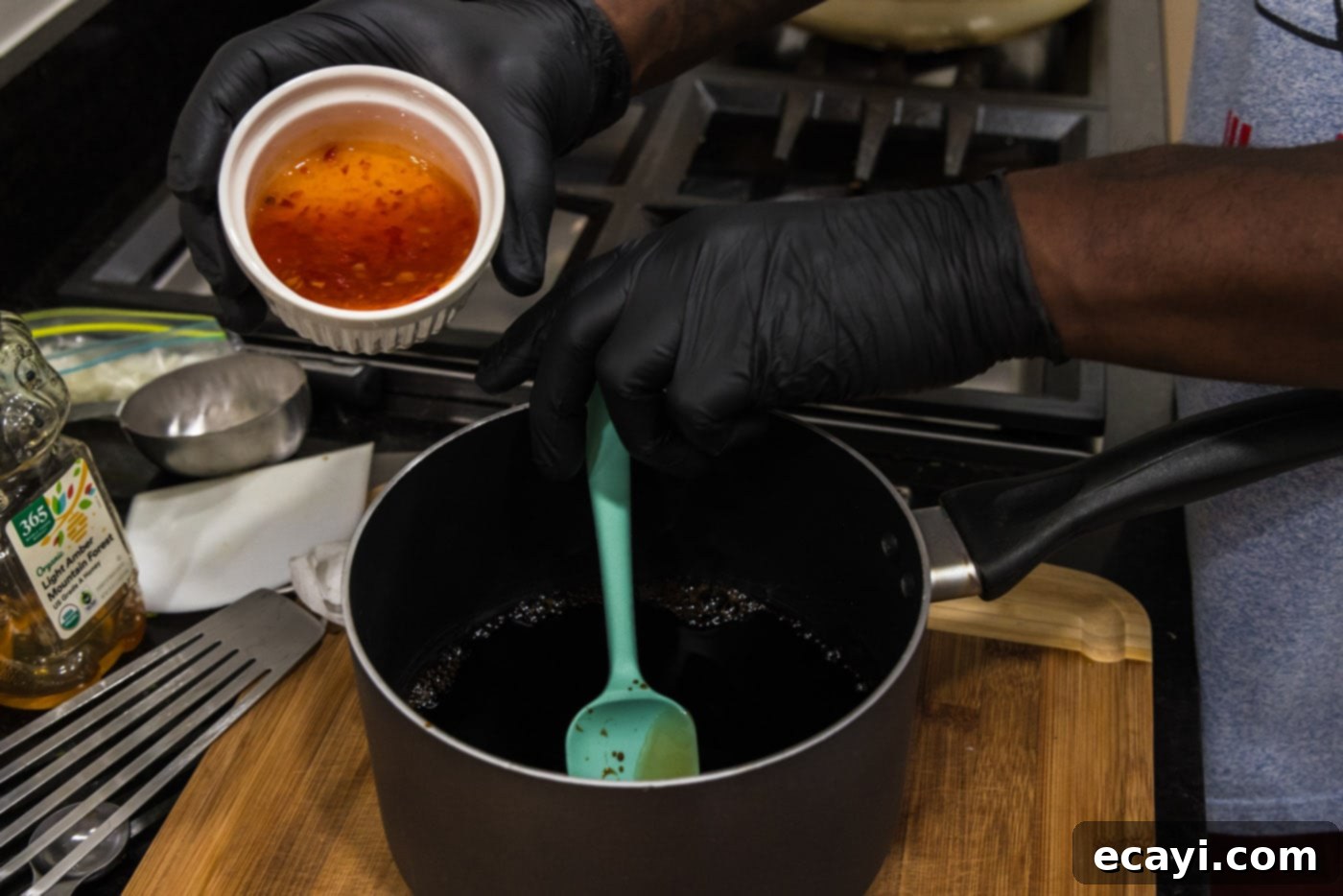
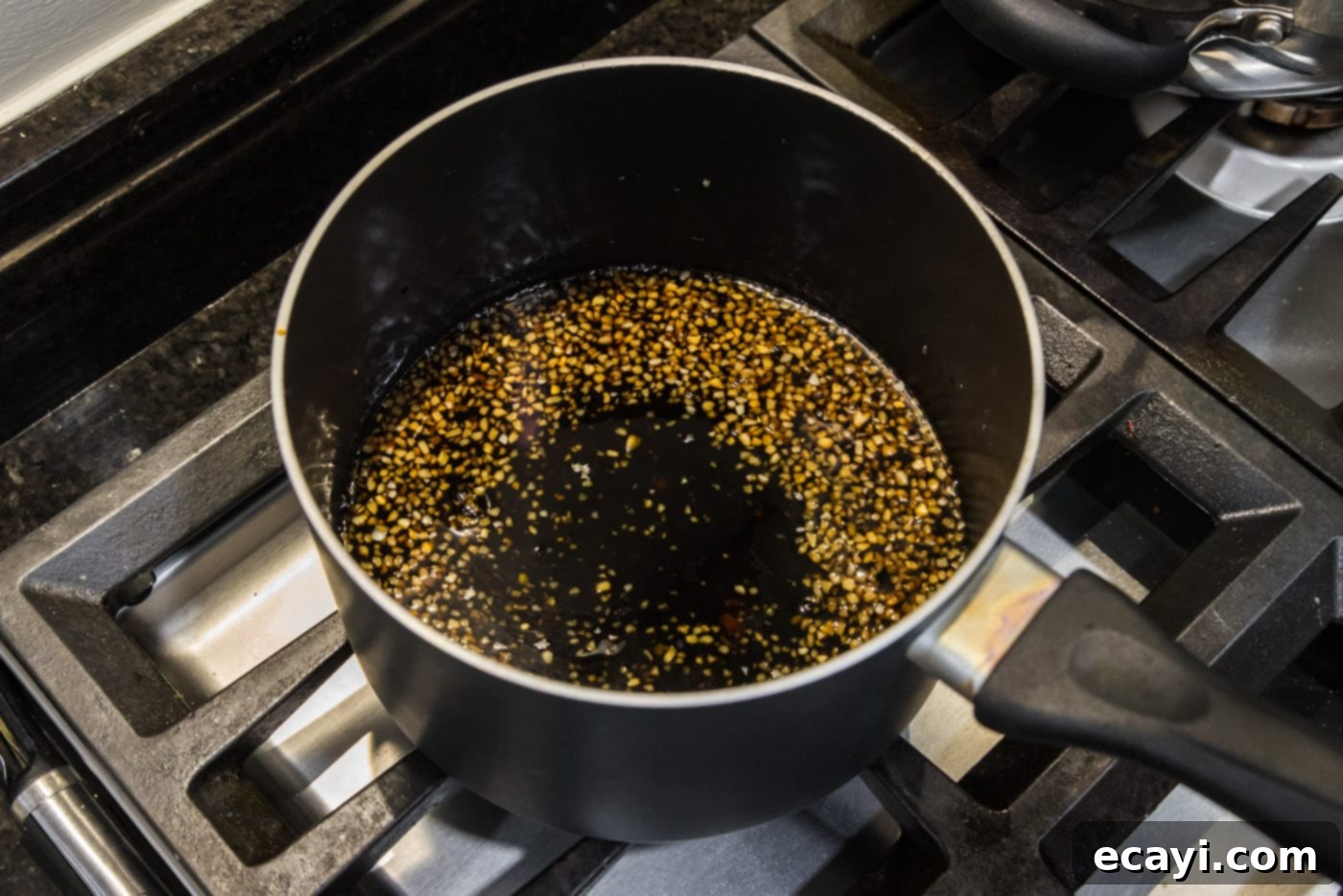
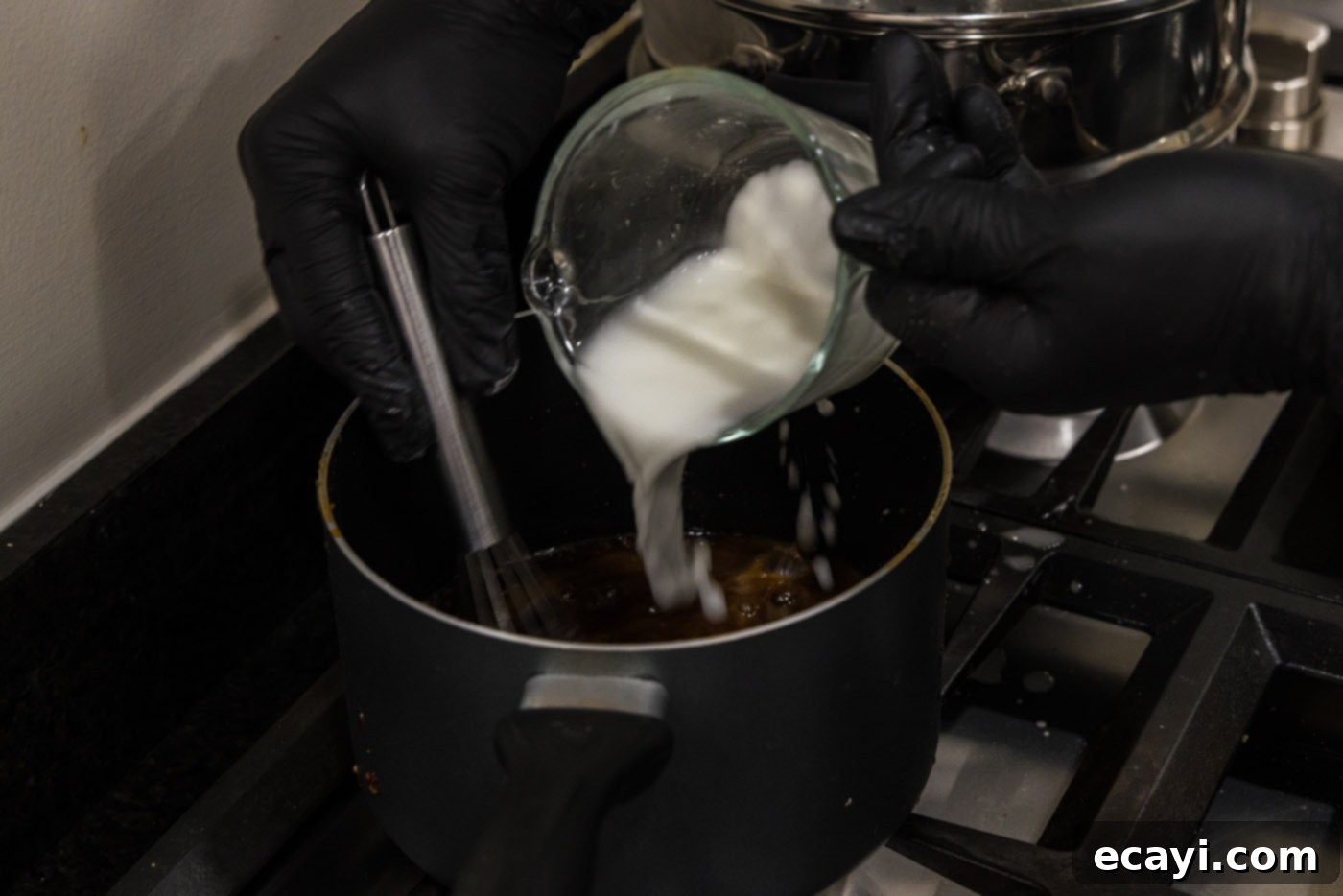
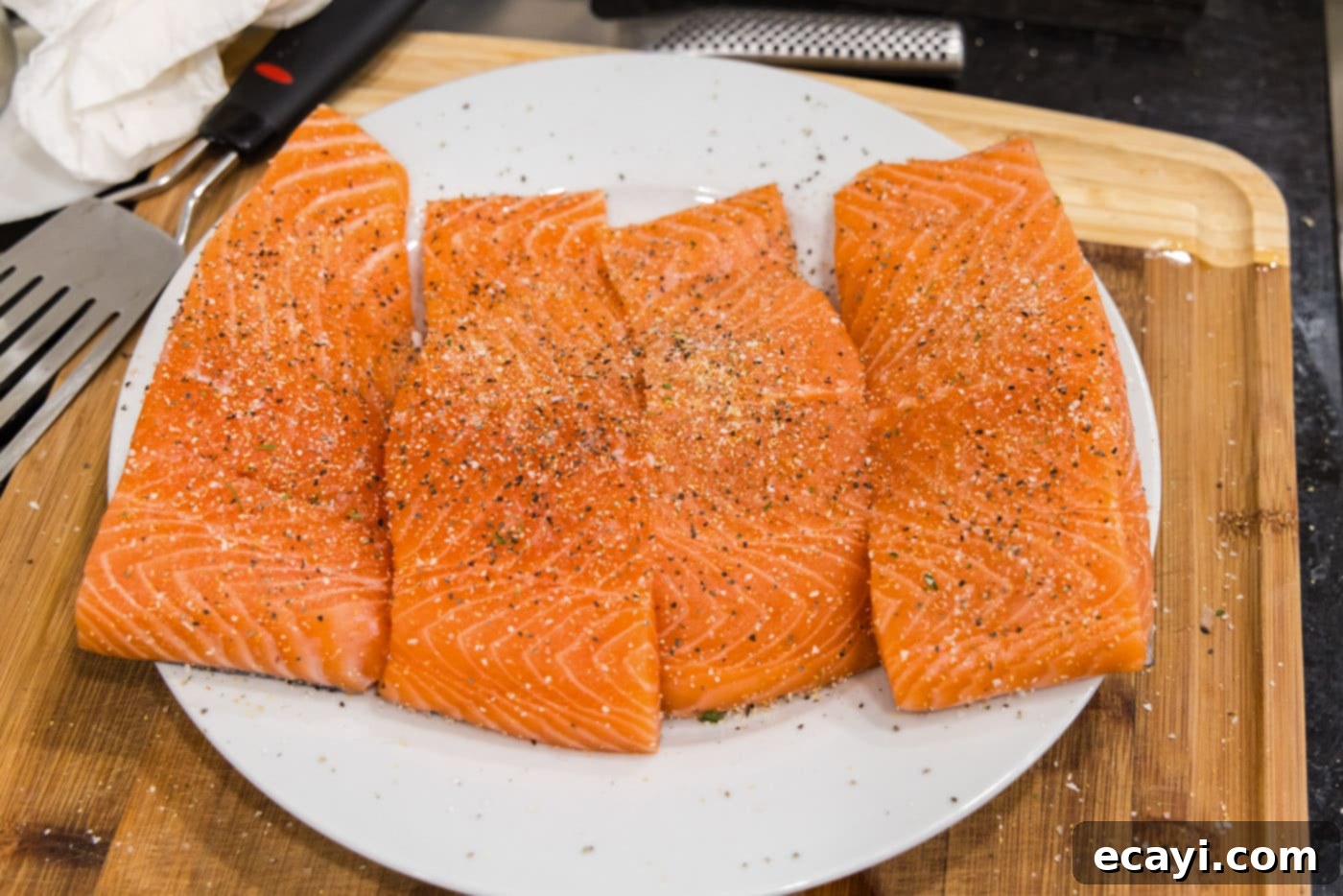
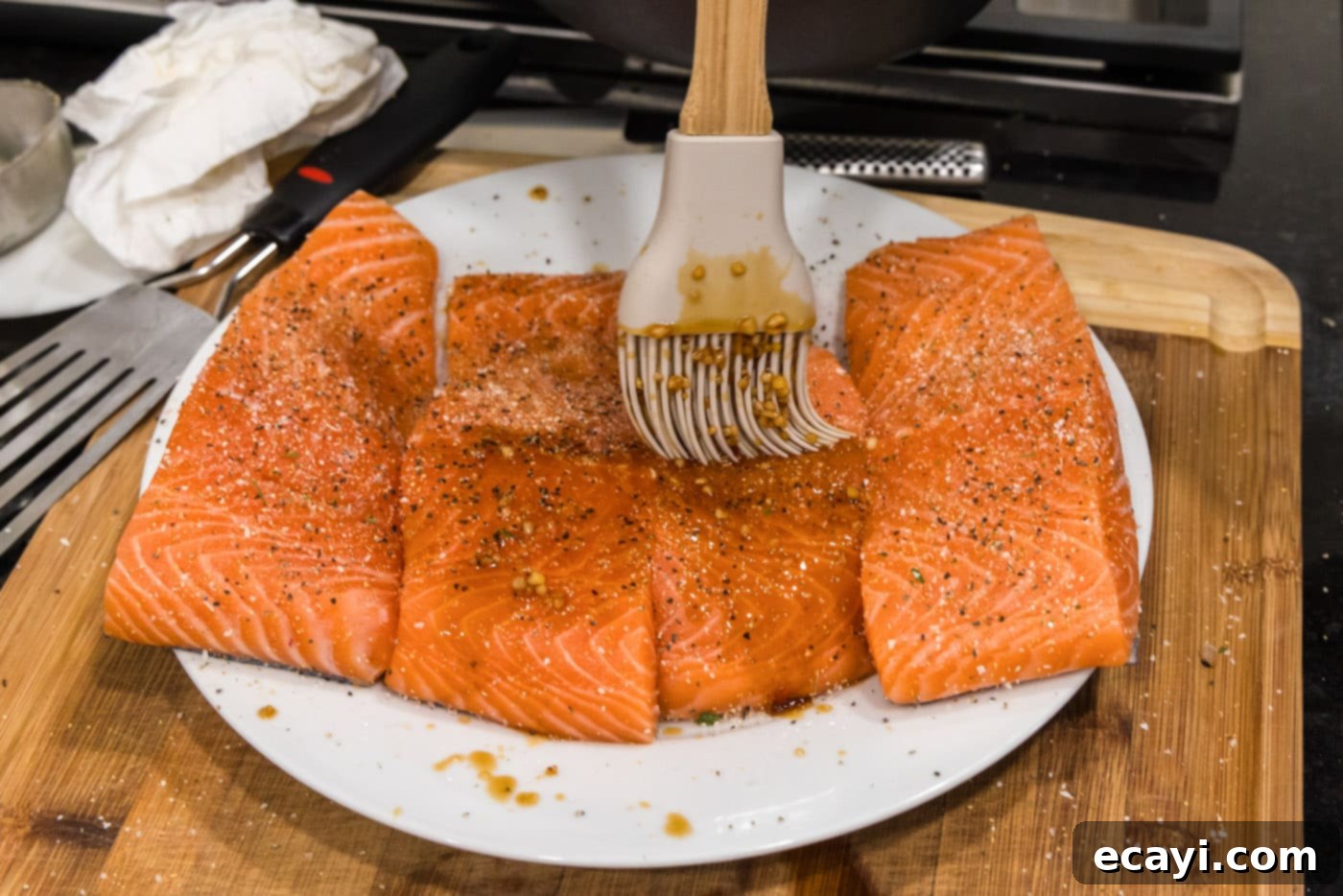
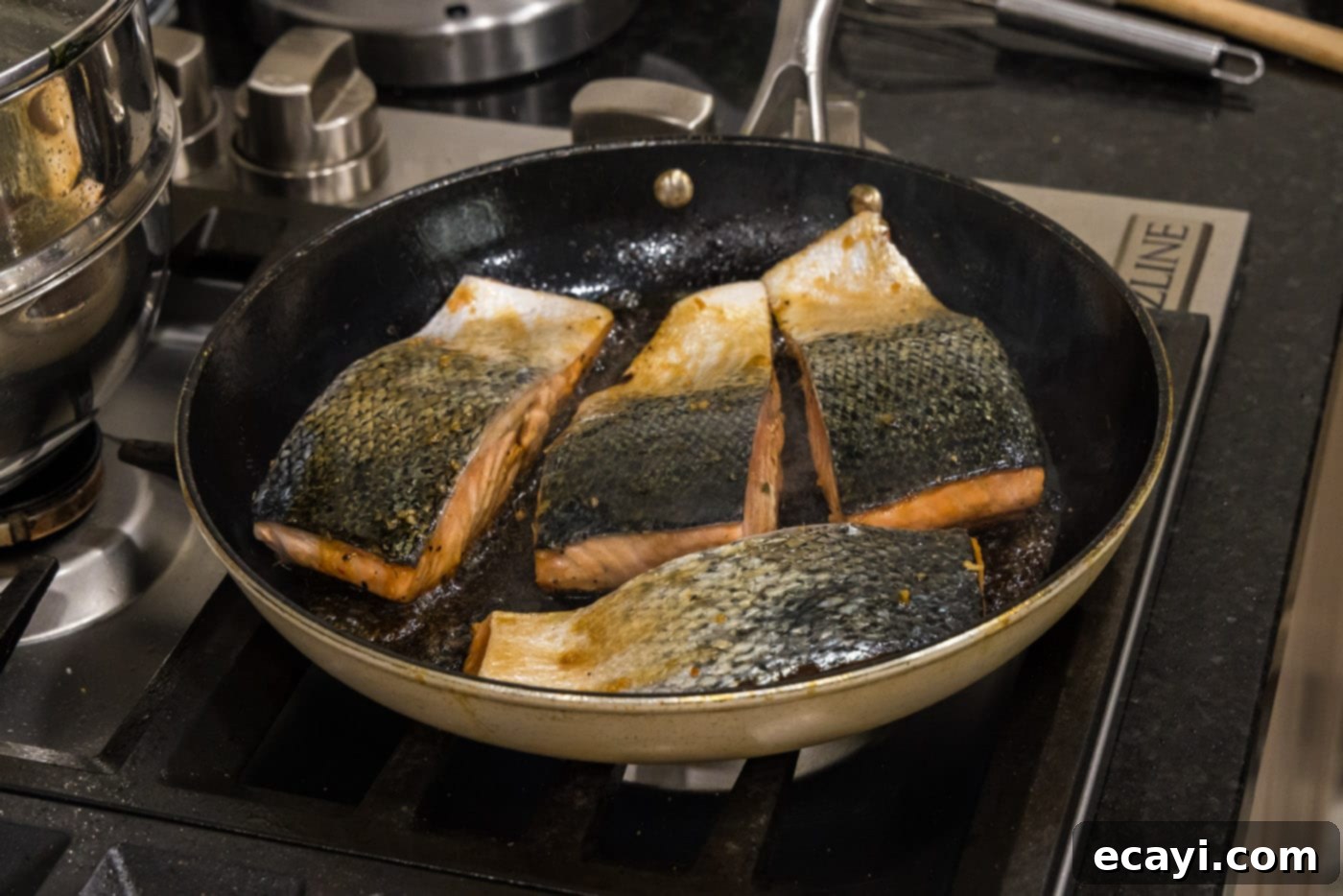
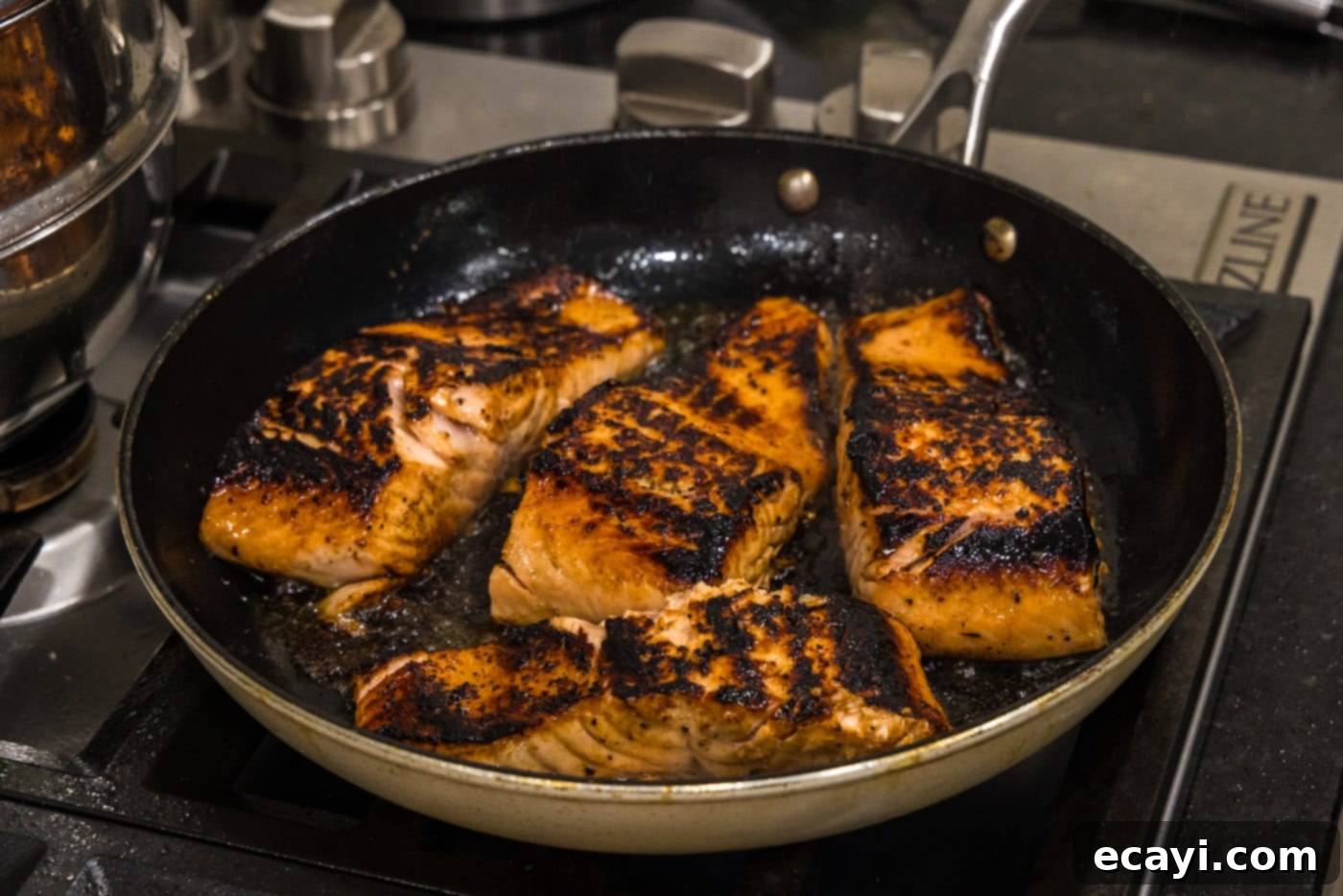
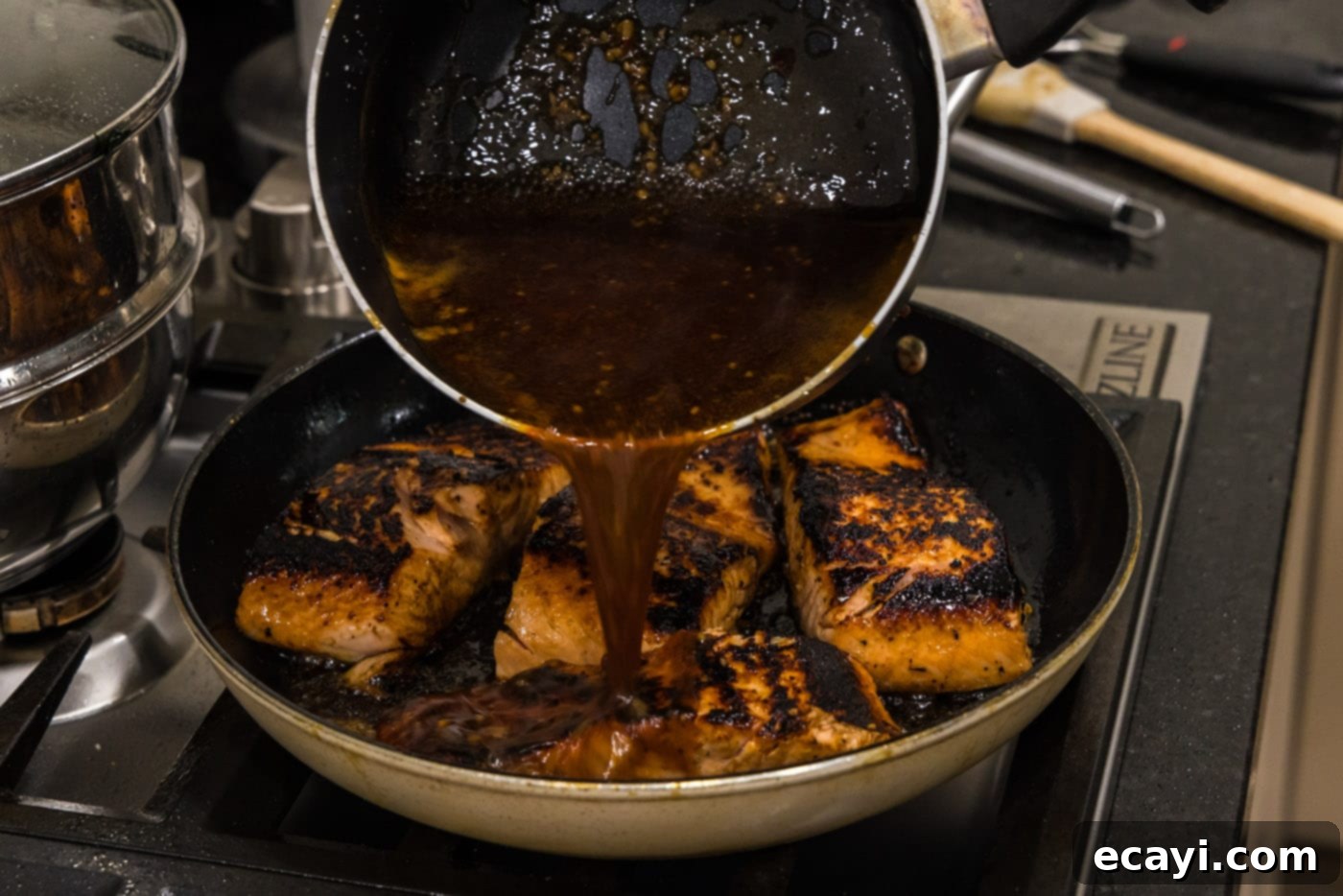
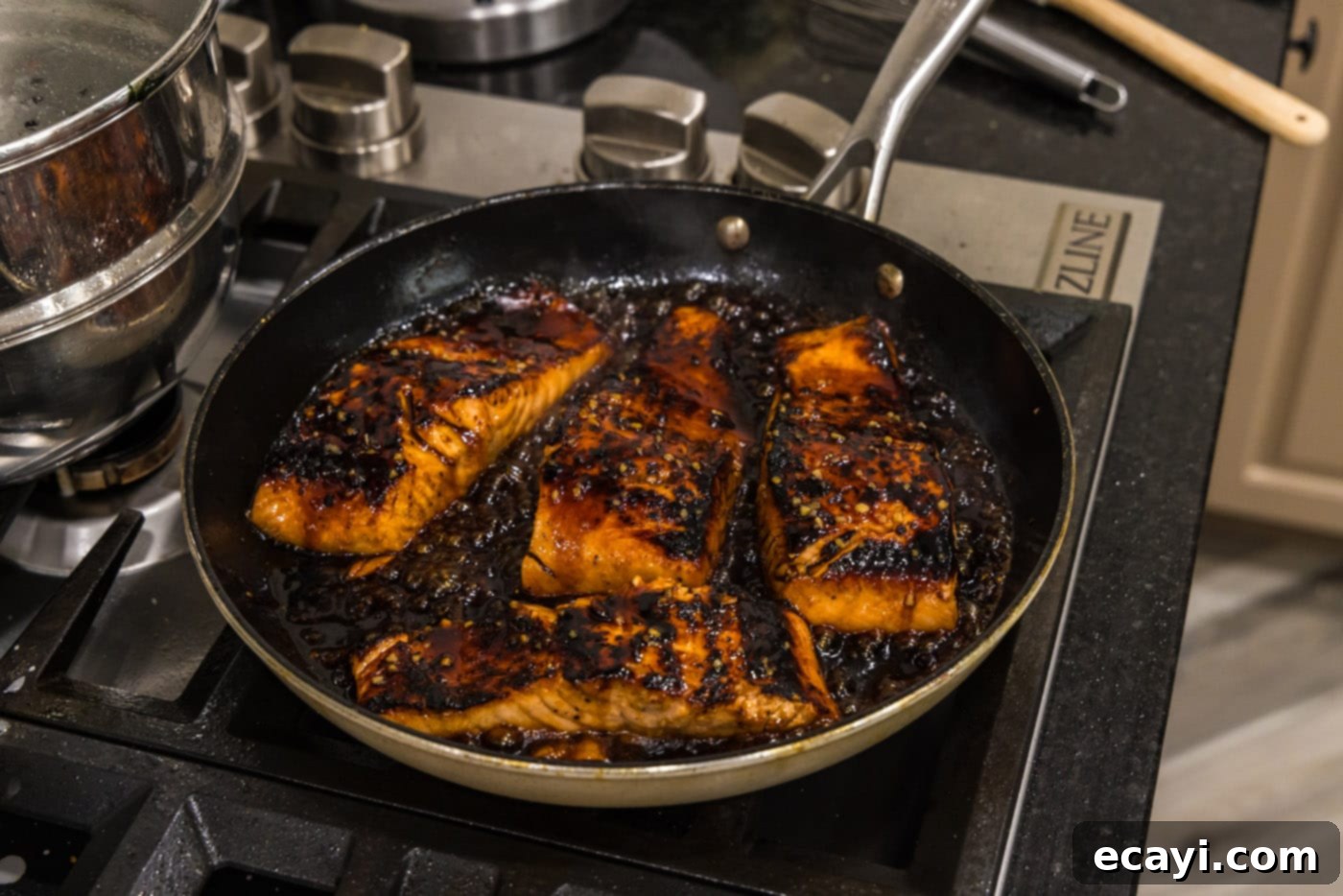
Frequently Asked Questions & Expert Tips for Success
Determining the perfect doneness for salmon is key to a moist and tender result. To test your fillets, gently press your finger (or the tip of a knife if it’s too hot) onto the top center or the thickest part of the fillet. If it begins to flake easily or separate into layers, it’s done. Be careful not to overcook, as this can result in dry, overly flaky salmon. For precision, we highly recommend using an instant-read thermometer. Salmon is perfectly cooked when it reaches an internal temperature of 125-135°F (52-57°C) in the thickest part of the fillet. Remember that salmon will continue to cook slightly after being removed from the heat (carryover cooking), so aiming for the lower end of that range can prevent overcooking.
Store any leftover honey salmon in an airtight container in the refrigerator for up to 2 days. For the best quality and to prevent dryness, salmon is best enjoyed fresh. If reheating, gently warm the salmon in a microwave on low power or in a skillet over low heat until just heated through. Adding a small splash of water or extra glaze can help keep it moist. Avoid high heat, as it can dry out the fish quickly.
Absolutely! While pan-searing gives a wonderful crust, this honey salmon is also delicious baked or air-fried. To bake, preheat your oven to 400°F (200°C). Place the glazed salmon fillets on a parchment-lined baking sheet and bake for 12-15 minutes, or until cooked through (125-135°F internal temperature). You can brush with extra glaze halfway through. For air frying, preheat your air fryer to 375°F (190°C). Place the glazed salmon in a single layer in the air fryer basket (you may need to cook in batches). Air fry for 10-14 minutes, flipping once and brushing with extra glaze, until cooked to your liking.
Crispy salmon skin is a delightful treat! The key is to start with very dry salmon. After patting the fillets dry with paper towels, you can even let them air-dry in the refrigerator for 30 minutes to an hour on a wire rack. When searing, place the salmon skin-side down in a hot skillet with olive oil. Apply gentle pressure with a spatula for the first minute or two to ensure full contact with the pan. Cook skin-side down for about 70-80% of the total cooking time (roughly 5-7 minutes for an 8oz fillet) until the skin is golden brown and crispy, then flip to finish cooking on the flesh side for just a couple of minutes. The glaze will be applied primarily to the flesh side during this process to maintain skin crispness.
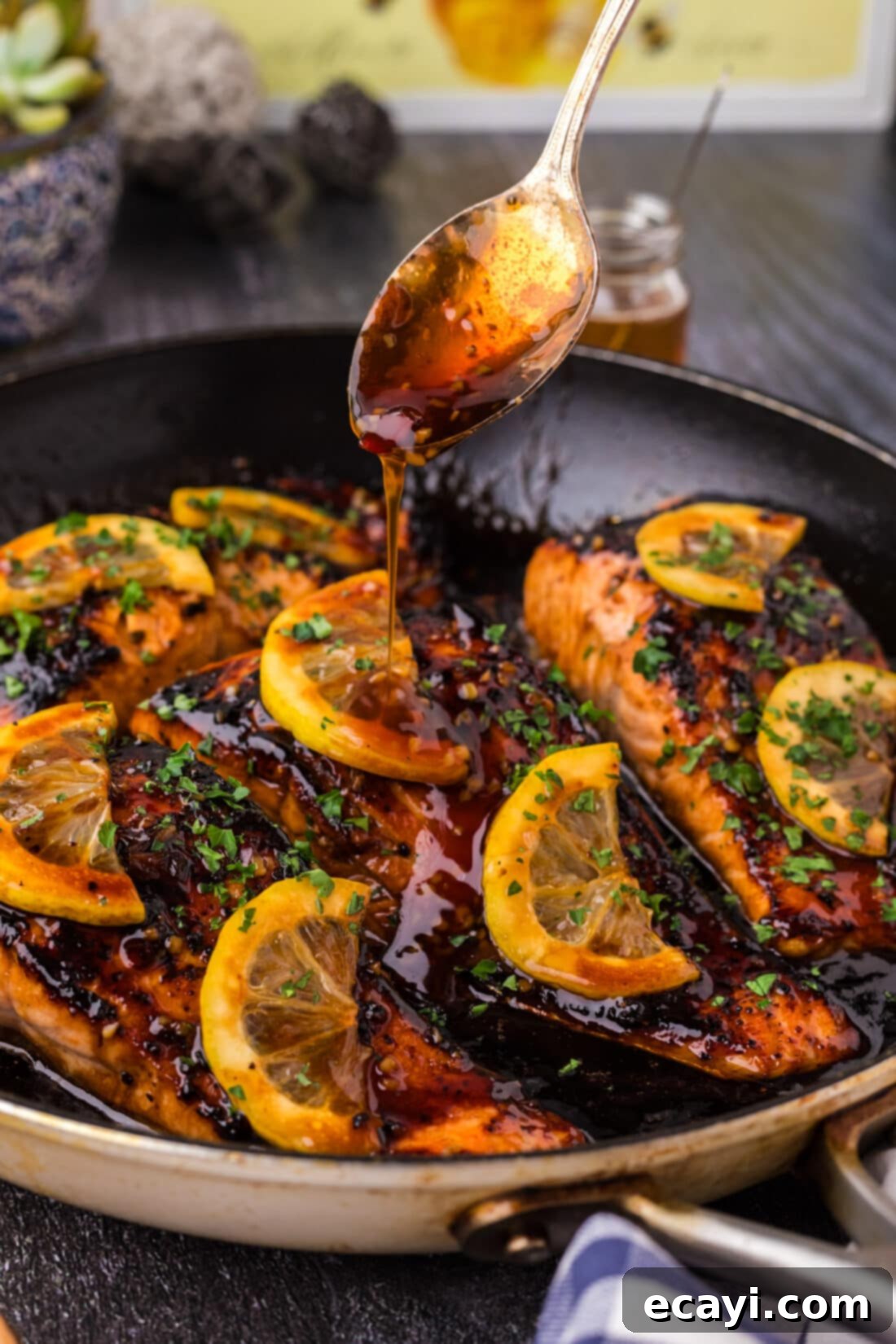
Delicious Serving Suggestions for Honey Salmon
This honey glazed salmon is incredibly versatile and pairs wonderfully with a variety of side dishes. For a complete and satisfying meal, serve your perfectly cooked salmon fillets over a bed of fluffy white rice, brown rice, or even quinoa. To add vibrant color and essential nutrients, consider accompanying it with a side of roasted or steamed vegetables. Excellent choices include crisp green beans, tender asparagus, broccoli florets, or savory Brussels sprouts. The possibilities are endless!
Remember that extra batch of glaze we talked about? It’s perfect for drizzling generously over your chosen side dishes, infusing every component of your meal with that delightful sweet and savory flavor. Alternatively, store any leftover glaze in the refrigerator in an airtight jar to use on future meals or as a dipping sauce. Enjoy this flavorful honey salmon warm, directly from the skillet, for the ultimate culinary experience.
More Irresistible Salmon Recipes to Explore
If you love salmon as much as we do, you’re in for a treat! Discover more fantastic ways to prepare this healthy and delicious fish:
- Stuffed Salmon
- Cajun Salmon
- Salmon Marinade
- Brown Sugar Salmon
- Crusted Salmon
I love to bake and cook and share my kitchen experience with all of you! Remembering to come back each day can be tough, that’s why I offer a convenient newsletter every time a new recipe posts. Simply subscribe and start receiving your free daily recipes!
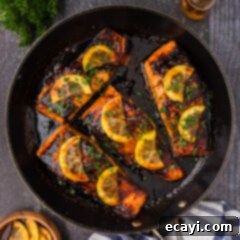
Honey Salmon
IMPORTANT – There are often Frequently Asked Questions within the blog post that you may find helpful. Simply scroll back up to read them!
Print It
Pin It
Rate It
Save ItSaved!
Ingredients
- 2 pounds center cut salmon filets
- garlic salt to taste
- black pepper to taste
- 2 Tablespoons olive oil
Sauce
- ¼ cup honey
- ¼ cup soy sauce
- 2 Tablespoons Asian sweet chili sauce
- 2 Tablespoons minced garlic
- ½ cup water
- 1 teaspoon cornstarch
Things You’ll Need
-
Saucepan
-
Large heavy bottomed skillet
-
Pastry brush
-
Fish turner
-
Whisk
Before You Begin
- For optimal and even cooking, choose center-cut salmon fillets, which offer uniform thickness. Use a sharp chef’s knife to portion your salmon into approximately 8-ounce servings. Fresh salmon is always recommended for the best flavor and texture; however, if using frozen salmon, ensure it is fully thawed in the refrigerator overnight before cooking. Patting the salmon completely dry with paper towels is essential for a good sear.
- To check if your salmon is perfectly cooked, gently press on the thickest part of the fillet with your finger or the tip of a knife. If it easily flakes and separates, it’s ready. Overcooked salmon tends to be dry and excessively flaky. For precise doneness, use an instant-read thermometer; salmon is done when it reaches an internal temperature of 125-135°F (52-57°C) in its thickest section.
- Leftover honey salmon can be stored in an airtight container in the refrigerator for up to 2 days. For best results, gently reheat on low heat to maintain moisture.
Instructions
Make The Sauce
-
Combine honey, soy sauce, Asian sweet chili sauce, and minced garlic in a saucepan. Stir well and bring to a boil over medium-high heat, stirring frequently. Remove from heat.
-
Create a slurry with cornstarch and water, then whisk it into the sauce. Heat briefly until the sauce begins to thicken into a glaze. Remove from heat.
Preparing The Salmon
-
Pat salmon fillets dry with paper towel, if needed. Season to taste with garlic salt and black pepper.
-
Add olive oil to a skillet and heat over medium-high heat until shimmering.
-
Brush seasoned salmon fillets with a generous amount of the glaze. Place salmon, skin side down, into the prepared skillet. Brush the skin side with additional sauce.
-
Cook for 6 minutes, observing the flesh change from pink to pale pink. Flip the fillets over with a fish turner spatula.
-
Add remaining sauce to the skillet and reduce heat to medium. Cook for an additional 3 minutes, or until the sauce is bubbly and the salmon is cooked through to your preferred doneness.
Nutrition
The recipes on this blog are tested with a conventional gas oven and gas stovetop. It’s important to note that some ovens, especially as they age, can cook and bake inconsistently. Using an inexpensive oven thermometer can assure you that your oven is truly heating to the proper temperature. If you use a toaster oven or countertop oven, please keep in mind that they may not distribute heat the same as a conventional full sized oven and you may need to adjust your cooking/baking times. In the case of recipes made with a pressure cooker, air fryer, slow cooker, or other appliance, a link to the appliances we use is listed within each respective recipe. For baking recipes where measurements are given by weight, please note that results may not be the same if cups are used instead, and we can’t guarantee success with that method.
